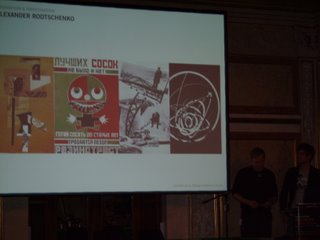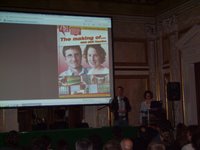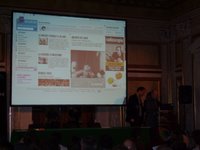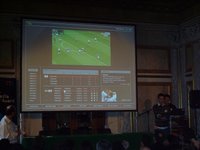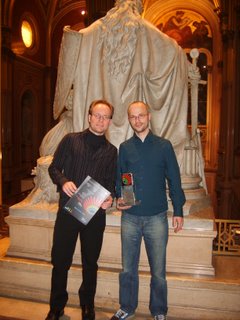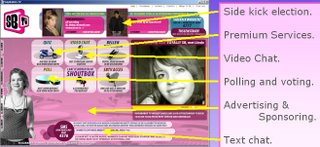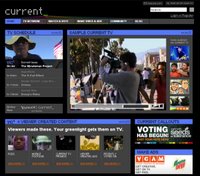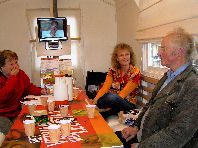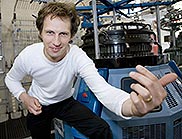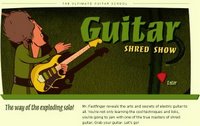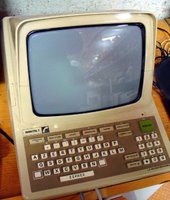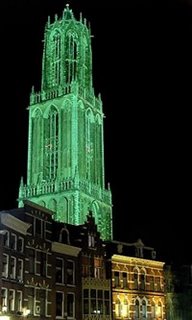Two of the nominations were variations on the same themes of the years past. Anna’s secrets was a PDA/GPS game. MORE for Graz was a PDA/GPS tourist guide application. The Austrian have produced several applications in this field such as a PDA walking assistant and a PDA ski assistant.
But this year there was a real innovation. Not with a PDA, but with a lot of electronic gear, hidden in shoes. Special engineered shoes, which might help people with handicaps (e.g. blind people) to walk an accidental course. The boots correct the feet positions, if needed. In his presentation the creator was asked whether he had found a manufacturer for this application; his answer was negative. It was a pity that no innovation consultants were in the room. In order to demonstrate the working the creator got on the table and started walking: these boots are made for walking…
Here are the laudations from the Festival brochure.
 Anna’s Secret (Germany) is a location-based adventure game that uses GPS localisation and a PDA to immerse the player into another era. Anna, an 18th century German countess, needs two players to solve the gaps and peculiarities of her old stories by searching the area for clues. Through solving her secret, users discover Weimar’s culturally historic sights.By walking through physical guideposts in the area, the GPS technology triggers the next clue in the game. Users must apply the general knowledge they acquire through the game to progress, or unlock the next clue by searching the location. Anna, for example, encourages users to explore the statues in Weimar’s beautiful Ilmpark or to look up books in the city library. Users are free to pause during the game or take any route. However her treasure must be found within the 75 minute time-limit.
Anna’s Secret (Germany) is a location-based adventure game that uses GPS localisation and a PDA to immerse the player into another era. Anna, an 18th century German countess, needs two players to solve the gaps and peculiarities of her old stories by searching the area for clues. Through solving her secret, users discover Weimar’s culturally historic sights.By walking through physical guideposts in the area, the GPS technology triggers the next clue in the game. Users must apply the general knowledge they acquire through the game to progress, or unlock the next clue by searching the location. Anna, for example, encourages users to explore the statues in Weimar’s beautiful Ilmpark or to look up books in the city library. Users are free to pause during the game or take any route. However her treasure must be found within the 75 minute time-limit.Team: Jan Ulrich Schmidt
 CabBoots (Germany) are specially engineered shoes which tell your feet where to go using a pedestrian guidance application. Most natural paths have a concave shape. If one foot is at the edge, the feet intuitively countersteer themselves against the angle. Using this principle, the electromechanic parts in the sole of CabBoots are able to generate the angle of the shoes and feet artificially. By using the kinaesthetic cognition of the foot and ankle, these shoes can intuitively guide users from A to B or to nearby points-of-interest without hitting obstacles. Tests with the prototype demonstrate that the principle of “walking on a path” also works with the virtually produced topography. In future developments, the computer could be embedded in the shoes and the software for positioning and generating the path will be able to run on any mobile device and connect wirelessly to the shoes using GPS. CabBoots has the potential to transform the lives of blind people.
CabBoots (Germany) are specially engineered shoes which tell your feet where to go using a pedestrian guidance application. Most natural paths have a concave shape. If one foot is at the edge, the feet intuitively countersteer themselves against the angle. Using this principle, the electromechanic parts in the sole of CabBoots are able to generate the angle of the shoes and feet artificially. By using the kinaesthetic cognition of the foot and ankle, these shoes can intuitively guide users from A to B or to nearby points-of-interest without hitting obstacles. Tests with the prototype demonstrate that the principle of “walking on a path” also works with the virtually produced topography. In future developments, the computer could be embedded in the shoes and the software for positioning and generating the path will be able to run on any mobile device and connect wirelessly to the shoes using GPS. CabBoots has the potential to transform the lives of blind people.Team: Martin Frey
 MORE for Graz (Austria) allows anyone to find out interesting historical information as they wander around this Austrian city. Users simply start the application on their Internet connected smartphone and take a photo of a building. They will promptly receive a detailed text and picture based description from the server. The sophisticated object recognition software functions regardless of the environmental conditions or photo angle. The client application can be installed directly via an Internet connection or PC onto a mobile phone. The portal also offers customers the possibility to present their digital photo album. The software could be easily commercially developed with a mobile phone operator as an MMS service, or it could be implemented on an Internet portal where customers purchase various packages for the object recognition service.
MORE for Graz (Austria) allows anyone to find out interesting historical information as they wander around this Austrian city. Users simply start the application on their Internet connected smartphone and take a photo of a building. They will promptly receive a detailed text and picture based description from the server. The sophisticated object recognition software functions regardless of the environmental conditions or photo angle. The client application can be installed directly via an Internet connection or PC onto a mobile phone. The portal also offers customers the possibility to present their digital photo album. The software could be easily commercially developed with a mobile phone operator as an MMS service, or it could be implemented on an Internet portal where customers purchase various packages for the object recognition service.Team: Stefan Ladstaetter, Alexander Almer, Christin Seifert, Gerald Fritz, Lucas Paletta, Patrick Luley
Tags: europrix, innovation
RSS feed: http://buziaulane.blogspot.com/rss.xml
Blog Posting Number: 588

